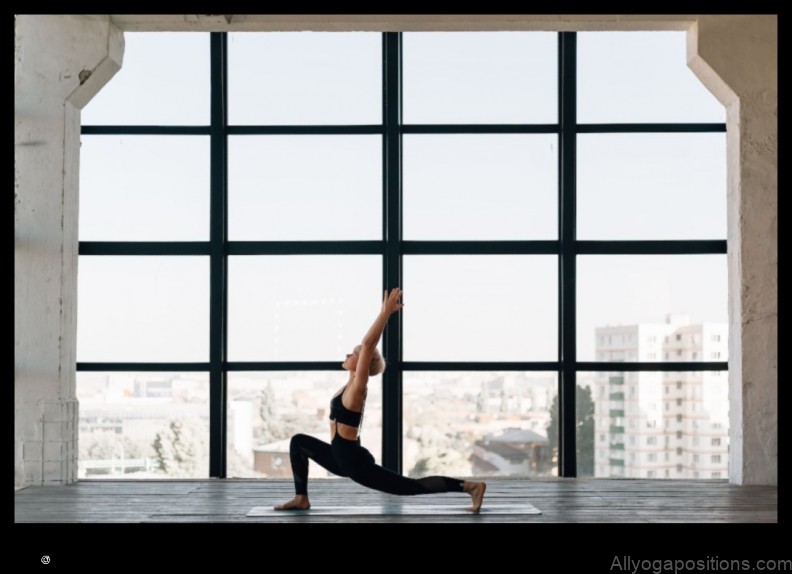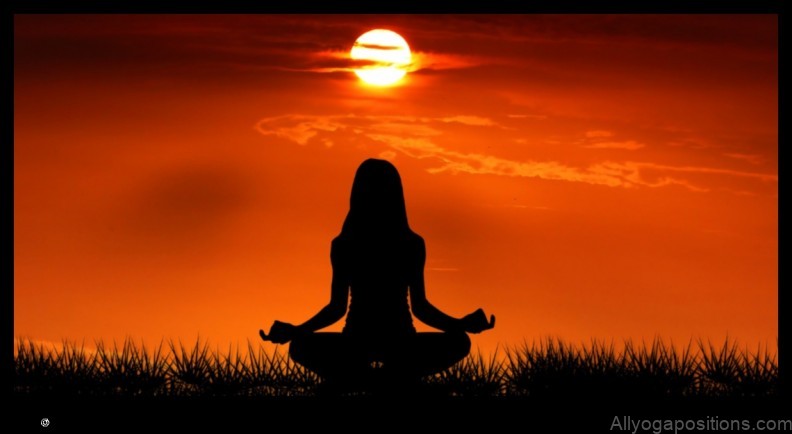
Mindfulness Meditation in Yoga
Mindfulness meditation is a type of meditation that involves paying attention to the present moment, without judgment. It can be practiced in any setting, but it is often done in conjunction with yoga. Yoga is a mind-body practice that involves poses, breathing exercises, and meditation. When practiced together, yoga and mindfulness meditation can help to improve physical and mental health.

Benefits of Yoga and Mindfulness Meditation
- Reduced stress and anxiety
- Improved mood
- Increased focus and concentration
- Improved sleep
- Reduced pain
- Enhanced immune function
- Improved overall well-being
How to Practice Yoga and Mindfulness Meditation
To practice yoga and mindfulness meditation, you will need a yoga mat, comfortable clothing, and a quiet place to practice. You can find many different guided meditations online or in books. If you are new to meditation, it is helpful to start with a guided meditation.
Once you have found a comfortable position, begin by focusing on your breath. Notice the feeling of the air as it enters and leaves your body. As you breathe, try to let go of any thoughts or worries that come to mind. Continue to focus on your breath for a few minutes.
Once you are feeling more relaxed, you can begin to focus on your body. Notice the sensations in your feet, legs, torso, arms, and head. As you scan your body, try to let go of any tension or discomfort.
Continue to focus on your breath and body for as long as you like. When you are ready to end your meditation, gently open your eyes and bring your attention back to the present moment.

Yoga and Mindfulness Meditation for Beginners
If you are new to yoga and mindfulness meditation, it is important to start slowly and gradually increase the amount of time you practice each day. You may also want to consider working with a qualified instructor or therapist.
Here are a few tips for beginners:
- Choose a comfortable yoga pose. If you are new to yoga, start with a simple pose such as child’s pose or seated forward bend.
- Focus on your breath. As you breathe, try to let go of any thoughts or worries that come to mind.
- Be patient with yourself. It takes time to develop a regular yoga and meditation practice.

Yoga and Mindfulness Meditation for Stress Relief
Yoga and mindfulness meditation can be very helpful for reducing stress. When you practice yoga, you are focusing on your breath and body, which can help to bring you into the present moment and reduce your stress levels. Mindfulness meditation can also help to reduce stress by teaching you how to observe your thoughts and feelings without judgment.
If you are looking for a way to reduce stress, yoga and mindfulness meditation can be a great option. Here are a few tips for using yoga and mindfulness meditation to reduce stress:
- Practice yoga and mindfulness meditation regularly. The more you practice, the more benefits you will experience.
- Find a quiet place to practice where you will not be disturbed.
- Focus on your breath and body as you practice.
- Let go of any thoughts or worries that come to mind.
Yoga and Mindfulness Meditation for Pain Relief
Yoga and mindfulness meditation can be helpful for reducing pain. When you practice yoga, you are stretching and strengthening your muscles, which can help to relieve pain. Mindfulness meditation can also help to reduce pain by teaching you how to focus on the present moment and let go of any thoughts or worries that may be contributing to your pain.
If you are experiencing pain, yoga and mindfulness meditation can be a great way to find relief. Here are a few tips for using yoga and mindfulness meditation to relieve pain:
- Practice yoga and mindfulness meditation regularly. The more you practice, the more benefits you will experience.
- Reduced stress
- Improved mood
- Increased mindfulness
- Improved flexibility
- Increased strength
- Improved balance
- Improved focus and concentration
- Start by choosing a comfortable yoga pose. You can sit in a chair, cross-legged on the floor, or lie down.
- Close your eyes and take a few deep breaths.
- Begin to focus on your breath. Notice the feeling of the air as it enters and leaves your body.
- As you breathe, bring your attention to your body. Notice the sensations in your feet, legs, torso, arms, and head.
- If you find your mind wandering, gently bring your attention back to your breath.
- Continue to practice for as long as you like.
- Start slowly. Don’t try to do too much too soon. It’s important to listen to your body and pace yourself.
- Find a comfortable place to practice. You can do yoga and mindfulness meditation at home, in a yoga studio, or in a natural setting.
- Wear comfortable clothing. You should be able to move freely and easily.
- Use props if needed. Props can help you to get into the poses more easily and comfortably.
- Find a teacher or guide. A teacher or guide can help you to learn the basics of yoga and mindfulness meditation and can provide support and guidance as you practice.
- Standing forward bend
- Child’s pose
- Downward-facing dog
- Seated forward bend
- Corpse pose
- Breathing meditation
- Body scan meditation
- Guided meditation
- Mindfulness walking
- Mindfulness eating
- Reduced levels of cortisol, a stress hormone
- Improved mood and sleep quality
- Increased feelings of relaxation and calm
- Enhanced immune function
- Improved pain management
- Practice yoga and mindfulness meditation at the same time each day, preferably in the evening.
- Make sure to find a quiet and comfortable place to practice.
- Wear loose, comfortable clothing.
- Start by practicing for a short period of time, gradually increasing the duration of your practice over time.
- Listen to your body and stop practicing if you feel tired or uncomfortable.
- Create a relaxing bedtime routine.
- Avoid caffeine and alcohol in the hours leading up to bedtime.
- Make sure your bedroom is dark, quiet, and cool.
- Get regular exercise, but avoid working out too close to bedtime.
- See a doctor if you have chronic sleep problems.
- Empowerment Embark Yoga for Courageous Beginnings
- Mindful Meadows Yoga for Grounded MindfulnessA Gentle Practice for Finding Peace and Tranquility in the Modern World
- Meditation and Holistic Health A Guide to a Mindful and Healthy Life
- Yoga for Emotional Balance Find Love and Connection Through Movement
- Meditation and the Art of Letting Go Detaching from Attachments for a Peaceful Mind
| Feature | Description |
|---|---|
| Mindfulness meditation | A type of meditation that focuses on paying attention to the present moment, without judgment. |
| Yoga | A mind-body practice that combines physical postures, breathing exercises, and meditation. |
| Meditation | A practice that involves training the mind to focus on a particular object or thought. |
| Mindfulness | A state of being aware of one’s thoughts, feelings, and bodily sensations in the present moment. |
| Relaxation | A state of physical and mental ease and calm. |
What is Yoga?
Yoga is a mind and body practice with a 5,000-year history in ancient Indian philosophy. It combines physical postures, breathing exercises, and meditation or relaxation.
Yoga is practiced in a variety of settings, from gyms and studios to community centers and parks. There are many different styles of yoga, each with its own unique emphasis. Some styles are more physically challenging, while others focus more on relaxation and meditation.
Yoga can be beneficial for people of all ages and fitness levels. It can help to improve flexibility, strength, balance, and coordination. It can also reduce stress, anxiety, and depression.
Yoga is a safe and effective way to improve your overall health and well-being. If you are interested in learning more about yoga, there are many resources available to help you get started.
III. What is Mindfulness Meditation?
Mindfulness meditation is a type of meditation that involves paying attention to the present moment, without judgment. It is a way of training the mind to be more aware of our thoughts, feelings, and bodily sensations. Mindfulness meditation can help us to reduce stress, improve our mood, and increase our focus.
Mindfulness meditation is often practiced in a seated position, with the eyes closed. However, it can also be practiced while walking, standing, or lying down. When you practice mindfulness meditation, you simply focus on your breath and the sensations in your body. You try to let go of any thoughts or judgments that arise, and simply observe them without reacting to them.
Mindfulness meditation can be a challenging practice, but it is also very rewarding. With regular practice, you can learn to become more present and aware of your thoughts and feelings. This can lead to a greater sense of peace and well-being.
IV. Benefits of Yoga and Mindfulness Meditation
Yoga and mindfulness meditation have a number of benefits in common, including stress relief, improved mood, and increased mindfulness.
In addition, yoga can help to improve flexibility, strength, and balance, while mindfulness meditation can help to improve focus and concentration.
Some of the specific benefits of yoga and mindfulness meditation include:
If you are looking for a way to reduce stress, improve your mood, and increase your mindfulness, yoga and mindfulness meditation may be a good option for you.
Talk to your doctor or a qualified yoga instructor to learn more about how yoga and mindfulness meditation can benefit you.
V. How to Practice Yoga and Mindfulness Meditation
Yoga and mindfulness meditation are two practices that can be combined to create a powerful mind-body experience. When you practice yoga, you are moving your body in a way that is both physically and mentally challenging. This can help to release tension and stress, and it can also improve your flexibility and strength. Mindfulness meditation is a practice of paying attention to the present moment, without judgment. This can help to increase your awareness of your thoughts and feelings, and it can also help you to relax and reduce stress.
When you combine yoga and mindfulness meditation, you are creating a practice that can help you to improve your physical and mental health. You are also creating a practice that can help you to connect with yourself and with the world around you.
Here are some tips for practicing yoga and mindfulness meditation together:
Yoga and mindfulness meditation can be a challenging practice, but it is also a very rewarding one. With regular practice, you can learn to relax and focus your mind, and you can also improve your physical and mental health.
VI. Yoga and Mindfulness Meditation for Beginners
Yoga and mindfulness meditation are both powerful tools for stress relief and relaxation. When combined, they can be an even more effective way to manage stress and improve your overall well-being.
If you’re new to yoga and mindfulness meditation, here are a few tips to help you get started:
Here are some simple yoga poses that are great for beginners:
Here are some simple mindfulness meditation exercises that you can try:
Yoga and mindfulness meditation can be a great way to reduce stress, improve your mood, and increase your overall well-being. If you’re new to yoga and mindfulness meditation, start slowly and listen to your body. With a little practice, you’ll be amazed at the benefits that you can experience.
VII. Yoga and Mindfulness Meditation for Stress Relief
Yoga and mindfulness meditation are both effective stress-relieving practices. Yoga can help to reduce stress by improving physical and mental health, while mindfulness meditation can help to reduce stress by increasing awareness of the present moment and reducing negative thoughts. When combined, yoga and mindfulness meditation can be a powerful tool for reducing stress and improving overall well-being.
Here are some of the benefits of practicing yoga and mindfulness meditation for stress relief:
If you are looking for a natural way to reduce stress, yoga and mindfulness meditation are a great option. These practices can help to improve your physical and mental health, and can make you feel more relaxed and at ease.
Yoga and Mindfulness Meditation for Pain Relief
Yoga and mindfulness meditation are both powerful tools for managing pain. Yoga can help to improve flexibility, strength, and balance, which can all contribute to reducing pain. Mindfulness meditation can help to reduce stress and anxiety, which can also contribute to pain relief.
When practiced together, yoga and mindfulness meditation can be a very effective way to manage pain. Yoga can help to provide relief from the physical symptoms of pain, while mindfulness meditation can help to address the mental and emotional aspects of pain.
If you are experiencing pain, you may want to consider incorporating yoga and mindfulness meditation into your treatment plan. Talk to your doctor or healthcare provider to see if these practices are right for you.
IX. Yoga and Mindfulness Meditation for Better Sleep
Yoga and mindfulness meditation are both effective for improving sleep quality. Yoga can help to relax the body and mind, while mindfulness meditation can help to reduce stress and anxiety. When combined, yoga and mindfulness meditation can create a powerful sleep aid that can help you to fall asleep faster and stay asleep longer.
Here are some tips for practicing yoga and mindfulness meditation for better sleep:
If you are struggling to sleep, you may also want to try some of the following tips:
Yoga and mindfulness meditation can be a powerful tool for improving sleep quality. By practicing these techniques regularly, you can help to reduce stress, relax your body, and improve your overall sleep.
X. FAQ
Q: What is the difference between mindfulness meditation and yoga?
A: Mindfulness meditation is a type of meditation that focuses on awareness of the present moment. Yoga is a mind-body practice that combines physical postures, breathing exercises, and meditation.
Q: How can I incorporate mindfulness meditation into my yoga practice?
A: You can incorporate mindfulness meditation into your yoga practice by taking some time before or after your yoga session to sit in silence and focus on your breath. You can also try to bring mindfulness to your yoga practice by paying attention to the sensations in your body as you move through the poses.
Q: What are some challenges people face when practicing mindfulness meditation?
A: Some challenges people face when practicing mindfulness meditation include distractions, boredom, and frustration. It is important to be patient with yourself and to not give up if you find it difficult to focus at first.
Table of Contents
